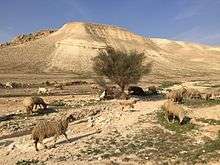Gilgal
Gilgal (Hebrew: גִּלְגָּל) is the name of one or more places in the Hebrew Bible. Gilgal is mentioned 39 times, in particular in the Book of Joshua as the place where the Israelites camped after crossing the Jordan River (Joshua 4:19 - 5:12).
Gilgal associated with Joshua
In the biblical narrative, Joshua orders the Israelites on the 10th of the Hebrew month Nisan, to take twelve stones from the river, one for each tribe, and place them there in memory. Israel Finkelstein claims this is an etiological myth created by the author of the Book of Joshua to explain the neolithic stone circle.[1]

According to the biblical narrative, Joshua then orders the Israelites who had been born during the Exodus to be circumcised. The Bible refers to the place where this occurred as Givat Ha'aralot. Some scholars speculate that the stone circle was the (unnamed) religious sanctuary that was condemned in the Book of Amos (Amos 4:4, 5:5) and Book of Hosea (Hosea 4:15).[2]

Gilgal is said to have been "on the eastern border of Jericho" (Joshua 4:19). "Gilgal" is also mentioned in a list of places to divide the land under the leadership of Joshua (Joshua 15:7). It may also have been the place marked by the modern village Jiljulieh, southwest of Antipatris and northeast of Jaffa. But another Gilgal, under the slightly different form of Kilkilieh, lies about two miles east of Antipatris.
Gilgal in Deuteronomy
In the Book of Deuteronomy 11:29-30, Gilgal is a place across from Mount Gerizim and Mount Ebal.
Gilgal associated with Samuel
A place named Gilgal is mentioned in the Books of Samuel as having been included in Samuel's annual circuit, and as the location where he offered sacrifices after Saul was anointed as king, and where he renewed Saul's kingship together with the people (1 Samuel chapters 7 and 11). Again it is possible for this to yet another "circle of standing stones" (or the same one as mentioned in relation to Elijah and Elisha, as Bethel is on the circuit with Gilgal, and other assumed locations show Gilgal to be far further away than the other two locations), and significant that it is treated as a holy place by the biblical text, rather than as a heathen one.
It is also the place where Samuel hewed King Agag in pieces as Saul refused to obey the Word of the Lord and utterly destroy the Amalekites (1 Samuel 15: 32, 33).
Gilgal associated with Elijah and Elisha
In the Books of Kings, "Gilgal" is mentioned as the home of several prophets. The text states that Elijah and Elisha came from here when they went down to Bethel from Gilgal (2 Kings 2:1-2); suggesting that the place was in the vicinity of Bethel, and hence in a mountainous region, which is somewhat different from the place associated with Joshua. Since "Gilgal" literally means "circle of standing stones", it is quite plausible for there to have been more than one place named Gilgal, and although there are dissenting opinions, it is commonly held to be a different place to the one involved with Joshua; it has been identified with the village Jaljulia, about 11 kilometres (6.8 mi) north of Bethel. It is significant that the Books of Kings treat it as a place of holiness, suggesting that stone circles still had a positive religious value at the time the source text of the passages in question was written, rather than having been condemned as heathen by religious reforms.
Another opinion is that it is not different from the Book of Joshua, as it locates it near Bethel as does the Books of Chronicles.
References
- ↑ Israel Finkelstein, The Bible Unearthed
- ↑ Jewish Encyclopedia, Book of Joshua; Gilgal
See also
- Ancient underground quarry, Jordan Valley, possibly associated by the Byzantines with Gilgal and the "twelve stones"
External links
- Dror Eydar, In the footsteps of ancient Israelite kings, September 18, 2013
Coordinates: 32°01′59″N 35°28′33″E / 32.0330°N 35.4757°E